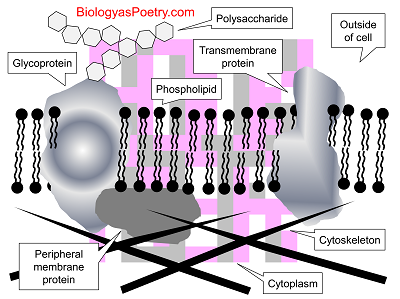∞ generated and posted on 2016.01.18 ∞
Fluid mosaic lipid bilayer that surrounds a cell, separating the cytoplasm on the inside from the extracellular environment on the outside.
| The Plasma Membrane is the cell membrane, that is, the membrane or lipid bilayer that contains the cytoplasm, also known as the cytoplasmic membrane. |
The plasma membrane is also known as the , as befitting its contact with as well as complete enclosure of a cell's cytoplasm. Both eukaryotic and prokaryotic cells possess plasma membranes. See also simply cell membrane.
Transport proteins embedded in the plasma membrane control the crossing of the numerous that require protein facilitation to enter or leave a cell. Passage of materials into or out of a cell, across the plasma membrane, can do so either to help the cell (such as by supplying nutrients), help the larger body (such as in the from the ), or can be harmful to the cell (which can be the case given exposure to or drugs).

Figure legend: Representation of a plasma membrane especially as seen with a eukaryotic cell. Note the lipid bilayer consisting of phospholipids, the peripheral membrane protein as well as transmembrane proteins. The glycoprotein is so-called because it is attached to the indicated polysaccharide. Note that the glycoprotein, as depicted, is also a transmembrane protein. The inner side of the membrane is in contact with the cell's cytoplasm, which contains numerous organelles (not shown) as well as the cell's cytoskeleton, which is depicted attached to membrane proteins. The various components, membrane proteins, carbohydrates, and phospholipids, are not drawn to scale.
The chemical environment inside of a cell differs from that of the outside to a large extent because the plasma membrane serves as a selectively permeable barrier between the two. A cell can impact the chemistry on both sides of this barrier though has much greater control over the interior.
See also inner membrane.